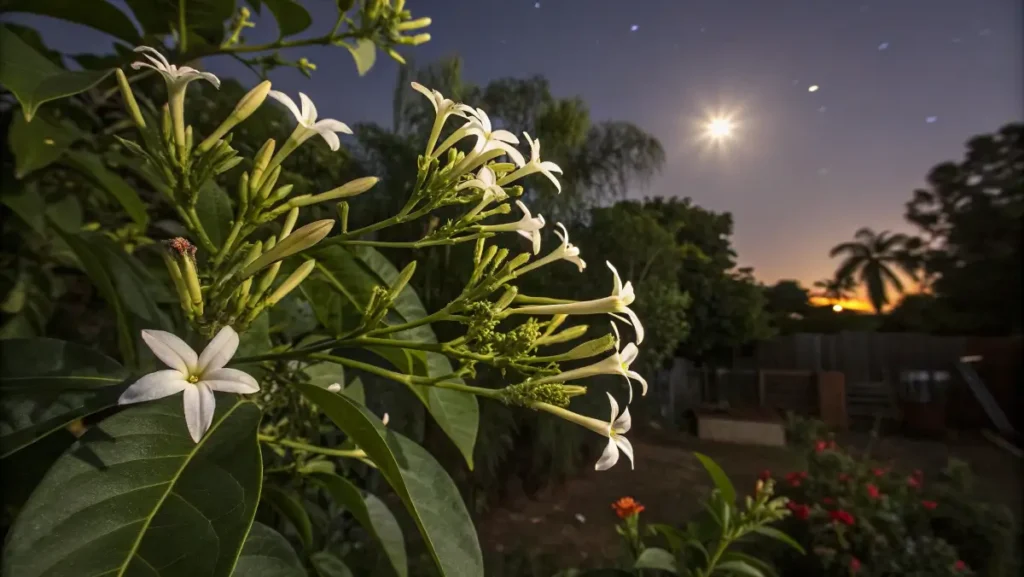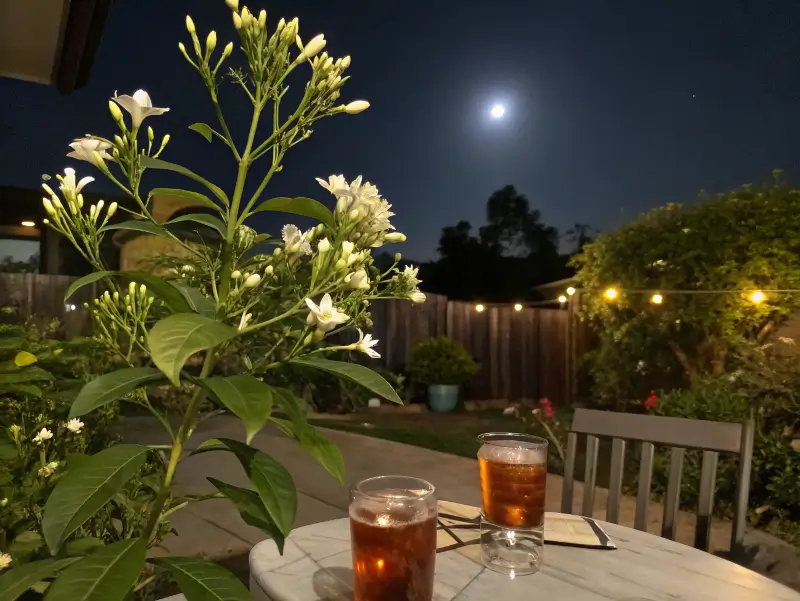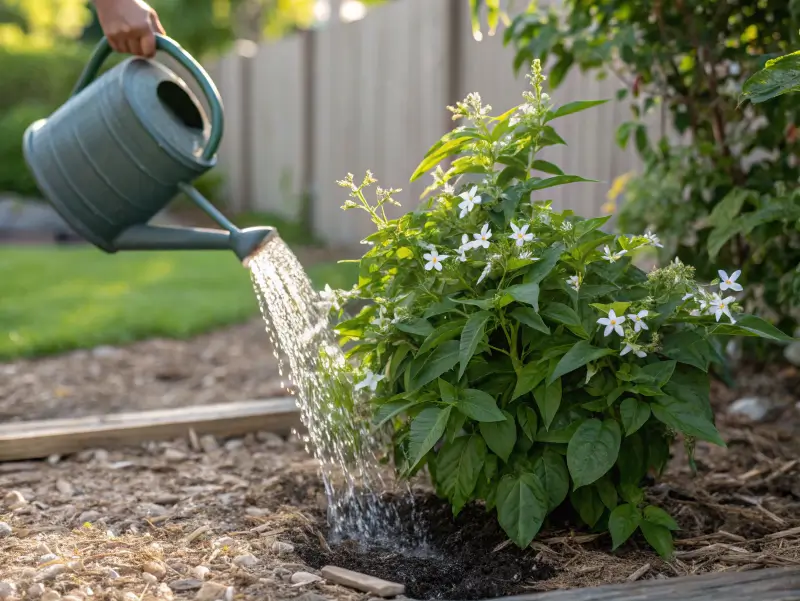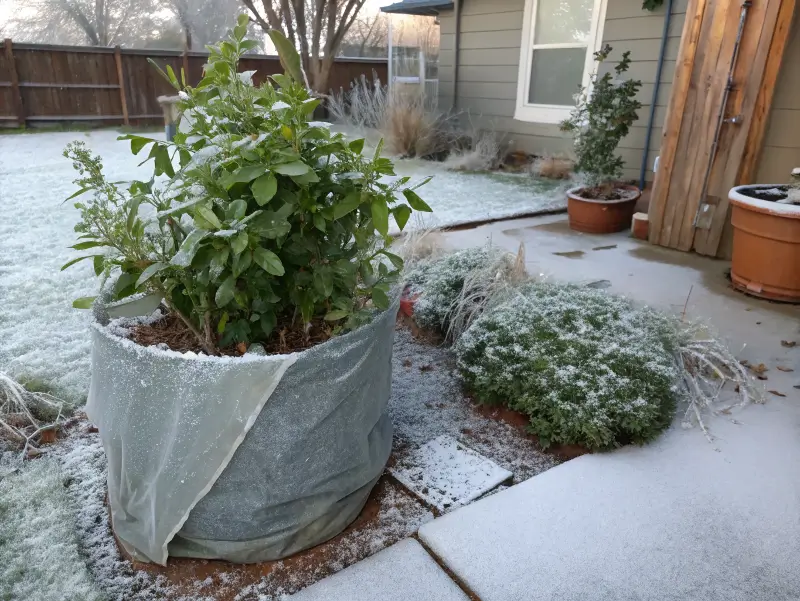
In This Article
Night blooming jasmine Plant (Cestrum nocturnum) is adored for its night-only flowers that release a sweet fragrance. Growing 4–8 feet tall, it features glossy leaves and thrives with partial sun, moderate watering, and warm temperatures.
Easy to care for, the plant’s nighttime blooms create a magical vibe. However, its berries and leaves can be toxic to pets if eaten. Overall, it’s a charming addition for those seeking a lovely evening scent.
Characteristics and Growth Habits

The Nocturnal Flowering Cycle
Unlike plants that bloom during the day, the night blooming jasmine plant waits until evening to put on its show. Around sundown, those buds gradually open, releasing a potent fragrance that intensifies as darkness takes over. This makes the jasmine night blooming plant a star attraction for moonlit gatherings. Some folks even create special “moon gardens,” featuring bright blossoms that glow under the light of the moon.
- Buds stay closed in daylight
- Fragrance peaks from dusk to midnight
- Ideal for those with busy daytime schedules
Personally, I love sitting outside at 10 p.m., sipping an iced tea, letting that dreamy scent surround me.
Fragrance and Pollinators
If you’ve ever wondered why it smells so strong, it’s partly because night pollinators rely on scent more than sight. The night blooming jasmine plant uses its perfume like a beacon, attracting moths from pretty far away. I’ve heard stories of people stepping outside on a calm summer evening and catching the fragrance from several yards down the street. That’s some powerful flower magic, if you ask me.
Night blooming jasmine Plant Care

Smart Watering Tips
When I talk night blooming jasmine plant care, I always stress the importance of proper watering. These plants don’t love to be drenched, but they dislike being super dry too. I usually:
- Water deeply once a week in summer
- Let the top inch of soil dry between waterings
- Add mulch to lock in moisture
If you see droopy leaves, that’s a hint it needs a drink. Too much water can lead to root issues, so watch out.
Simple Fertilizing and Pruning
Light feeding during spring helps keep the night blooming jasmine plant vigorous. I tend to use a balanced, water-soluble fertilizer, but I avoid overdoing it. Meanwhile, a bit of pruning in late winter or early spring will keep the shape tidy and let new growth emerge.
- Prune leggy branches
- Snip off any dead or diseased stems
- Use clean tools to avoid spreading problems
Trimming also boosts airflow, reducing the chance of pests. Honestly, it’s a must in night blooming jasmine plant care to keep it looking fresh.
Ideal Planting Conditions and Soil Requirements
Soil pH, Drainage, and Fertility
When it comes to night blooming jasmine plant care, I’m a big fan of well-draining soil. Clay might keep roots too wet, so I usually add sand and organic matter to lighten things up. A slightly acidic pH range of around 6 to 7 is my sweet spot. Here’s a quick list:
- Check pH with a simple test kit
- Incorporate compost to boost fertility
- Avoid constantly soggy ground
I’ve found that a well-balanced soil helps keep the night blooming jasmine plant from getting root rot, which can be a real bummer.
Container vs. In-Ground Planting
If you live in a spot with harsh winters, container planting is your best buddy because you can bring the pot indoors. I once lost a night blooming jasmine plant to a sudden freeze, and that was no fun. On the flip side, if you’re in a tropical or subtropical area, planting it directly in your ground is awesome:
- Container planting = easy mobility
- In-ground planting = deeper root growth
- Keep an eye on temperature dips
Sometimes, I bring it indoors in December when nighttime temps fall. No shame in protecting your baby from the cold!
Propagation Methods for Night blooming jasmine Plant
Seeds or Stem Cuttings
Some folks start a night blooming jasmine plant from seeds, but I’ve found it easier to use stem cuttings. If you cut a branch that’s a few inches long, remove the lower leaves, and place it in a glass of water, roots might form in a few weeks.
- Use rooting hormone for quicker root growth (optional)
- Transfer to soil once roots appear strong
- Keep the new cutting warm and slightly humid
Within one growing season, you could have a brand-new night jasmine plant for your porch or patio.
Hassle-Free Transplanting
When those new roots settle in, move your night blooming jasmine plant cutting gently into a pot with well-draining soil. Avoid rough handling because those baby roots can snap easily.
- Choose a pot slightly bigger than the root system
- Water lightly after transplant
- Place in a partially shaded spot for a week or two
I messed up one year by plunking a tender cutting in blazing sun too soon. It whimpered for a bit, but eventually bounced back once I found a cooler spot. Because these plants thrive in warmer weather, timing can help them adjust better.
Overwintering and Seasonal Care

Handling Frost and Cold Climates
I’ve got a routine for winter if I’m keeping my night blooming jasmine plant outside. Covering it with a breathable frost cloth on cold nights helps. If the temperature plunges drastically—like below 40°F—I’d recommend bringing it inside if it’s potted. Winter dryness can also be rough, so I occasionally mist the leaves.
- Use frost cloth or old sheets for brief cold snaps
- Move potted plants indoors before a freeze
- Water sparingly in winter
I recall a few winters ago when temps dipped unexpectedly in February. My plant survived, but I had to hustle it inside at the last minute.
Encouraging Growth in Warmer Months
When spring rolls around, that’s the time to lighten the watering schedule and maybe feed a small dose of fertilizer. The night blooming jasmine plant typically starts perking up as daylight hours extend. By late spring or early summer, you should see those new bright green shoots.
- Prune away any winter damage
- Increase watering as temps rise
- Let it get morning sun to stimulate growth
This cycle repeats each year, so even if things go sideways one winter, it can often recover in time for prime blooming in the warmer seasons.
Managing Pests, Diseases in Night blooming jasmine Plant
Common Insects to Watch For
Though it’s generally hardy, the night blooming jasmine plant is not immune to pests. Whiteflies, aphids, and spider mites might appear if conditions are too moist or too crowded. To handle them:
- Spray leaves with a strong water jet
- Use mild soapy water to remove pests
- Keep good airflow by spacing out plants
I once had a spider mite invasion, and that was not cute. Thankfully, a homemade soap spray did the trick, and they left my night jasmine plant alone.
Potential Health Issues and Disadvantages
It’s worth noting that all parts of the night blooming jasmine plant can be toxic to pets or small kids if ingested. Plus, the fragrance, while lovely, may irritate those with sensitive noses. And in certain regions, the plant spreads quickly and might become invasive.
- Wear gloves when pruning if you have sensitive skin
- Keep children and pets from sampling the berries
- Prune regularly to stop unwanted spread
Some neighborhoods even ban or limit this plant, so check your local guidelines if you’re unsure. Still, as a plant lover, I think it’s mostly worth it!
Cultural Uses and Symbolism of the night blooming jasmine plant
Medicinal and Aromatic Traditions
Some folks believe the plant’s flowers hold mild relaxation properties. Others gather blossoms for potpourri or place them near an open window for a natural air freshener. If you want solid info on herbal uses and safety, you might check out official resources, like the U.S. Food & Drug Administration, for any guidelines on plant-based items.
- Personal aromatherapy by placing blooms in a bowl of water
- Dried petals for homemade sachets
- Cultural ceremonies in some parts of Southeast Asia
I haven’t tried making bouquets from night blooming jasmine, but I’ve heard it can add a soothing aroma to indoor spaces.
Symbolism in Different Regions
Because the night blooming jasmine plant unfurls at night, many see it as a symbol of hidden beauty that blooms only in the dark. Some folks link it to romance and nighttime gatherings. I’ve attended a few evening weddings where the bride carried a small cluster of night jasmine plant blossoms for an extra dash of intrigue. That’s pretty neat, right?
- Used in folklore to represent enchanting qualities
- Often seen in traditional moonlit garden designs
- A popular subject for local festivals
Overall, it holds a special place in the hearts of plant enthusiasts worldwide.
Understanding the night blooming jasmine plant
Botanical Classification of Cestrum nocturnum
The night blooming jasmine plant is often referred to as Cestrum nocturnum. Even though it’s called “jasmine,” it’s more closely related to tomatoes and peppers. Sounds weird, right? But as part of the nightshade family, this shrub has shiny green leaves and pale, tubular flowers that open just when most of us start to wind down for the night.
- Grows best in warm, mild climates
- Produces slender branches prone to quick growth
- Has small, white-green flowers
Because it’s not a true jasmine, some plant folks prefer calling it night cestrum. Personally, I’m not too picky—I’m just happy it smells amazing.
Common Cultural Beliefs
Different cultures hold the night blooming jasmine plant in high regard. Some believe it fills a garden with romantic vibes, while others appreciate its pollinator-friendly blooms. Moths and even some late-working bees show up for that sweet nectar, making it a cool piece of nighttime biodiversity. I remember reading that in certain places, people mention it in folk tales as a flower that “wakes up when everyone else dozes off.” There’s something neat about a plant that thrives in the moonlight.
FAQ
Does night-blooming jasmine come back every year?
Yes, most of the time. If you protect your night blooming jasmine plant from hard frosts, it normally returns each year. Even if it drops leaves in cold weather, new shoots can appear when warmer days arrive.
Does night-blooming jasmine like sun or shade?
It enjoys partial to full sun. In scorching summers, though, I’d give it some afternoon shade to prevent leaf burn. Morning sun works best in a lot of zones, so keep that in mind if you’re setting up your night blooming jasmine plant care schedule.
Where is the best place to plant a night-blooming jasmine?
Pick a spot with well-draining soil and decent sunlight. Also, consider placing it near a window, so you can catch that evening scent from inside. This can be super convenient during cooler months too.
What are the disadvantages of night-blooming jasmine?
It can be invasive in certain tropical climates. Plus, strong fragrance might cause issues for people with respiratory sensitivities, and the berries are toxic if eaten by pets or curious children. Regular pruning helps keep it in check.
Conclusion and Final Thoughts
I could chat all day about the night blooming jasmine plant. It’s a dreamy shrub that comes alive at night and sprinkles a sweet fragrance all around. Aside from regular night blooming jasmine care—which includes proper watering and light pruning—there’s not much fuss required. If you’re feeling adventurous, pair it with vibrant companions like the Black Dahlia Flower for an evening garden that’ll wow anyone who stops by.
- Water weekly in hot months
- Give partial sun and a bit of shade
- Prune carefully in late winter
As a bonus, the night blooming jasmine can be a perfect conversation starter at your next barbecue. Imagine your friends stepping into that gentle nighttime glow, inhaling the sweet perfume, and asking, “Wow, what’s that amazing smell?” That’s when you’ll grin and say, “Oh, that’s my night blooming jasmine plant, blooming just for us.”
If you want more gardening tips or you’re curious about how different shrubs handle seasonal changes, you can check the USDA’s Plants Database for detailed info on plant hardiness zones. Meanwhile, I hope you’ll enjoy the nightly wonders that the night blooming jasmine plant has to offer. Breathe in that fragrance, watch those buds open at dusk, and share this midnight treasure with the people you love.

2 thoughts on “How to Grow and Care for Night Blooming Jasmine Plant”
Comments are closed.